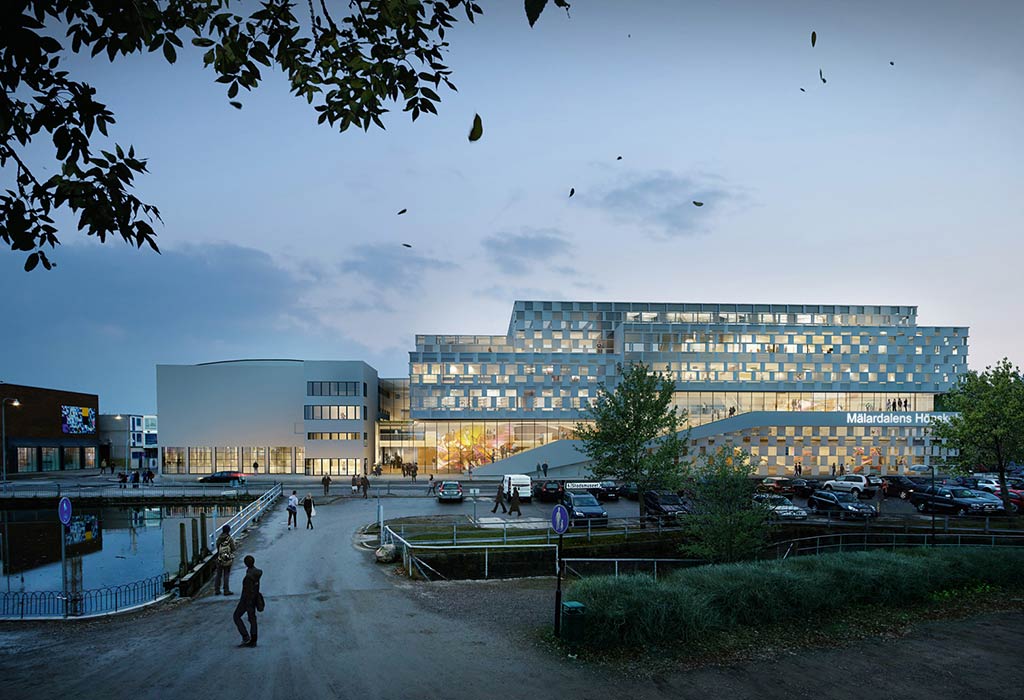Denmark-based architecture firm 3XN's design won the architectural competition for Mälardalen University's new educational facility in Eskilstuna, southwest of Stockholm, Architecturelab reports.
The new building's cubic shape, geometric trellis, and bright façade is a nod to the nearby historical, modernist public bathhouse designed by Paul Hedqvist in the 1930s.
The winning proposal is of a 196,441-sf structure that will house educational facilities and workplaces for 4,000 students and 350 students. The project is estimated to cost €49 million.
The firm said about the conversion:
"Internally, the new building connects to the public bath on the first to decks, creating a cohesive flow between old and new. The lower levels will be completely open and connected so that the new and old building seen as one functional and spatial whole. The volume of the main swimming pool is retained as the school library. By also locating the café and student house in the public bath, it becomes a unique social meeting place for the students.
"A central atrium, double-height auditoriums, open study areas and inner courtyards create a building with good visual connections between floors. Classrooms and lecture halls are located on the lower three floors. The administrative offices are at the top of the building, creating a more private working environment."
Related Stories
| Apr 5, 2011
Top 10 Buildings: Women in Architecture
Making selections of top buildings this week led to a surprising discovery about the representation of women in architecture, writes Tom Mallory, COO and co-founder, OpenBuildings.com. He discovered that finding female-created architecture, when excluding husband/wife teams, is extremely difficult and often the only work he came across was akin to interior design.
| Apr 5, 2011
What do Chengdu, Lagos, and Chicago have in common?
They’re all “world middleweight cities” that are likely to become regional megacities (10 million people) by 2025—along with Dongguan, Guangzhou, Hangzhou, Shenzhen, Tianjin, and Wuhan (China); Kinshasa (Democratic Republic of the Congo); Jakarta (Indonesia); Lahore (Pakistan); and Chennai (India), according to a new report from McKinsey Global Institute: “Urban World: Mapping the economic power of cities”.
| Mar 30, 2011
China's low-carbon future city
In 2005, the Chinese government announced its target to reduce energy consumption per GDP unit by 20% by the year 2010. After a multi-billion investment, that target has been reached. The Chinese Climate Protection Program’s goal to increase energy efficiency, develop renewable energies, and promote energy savings while reducing pollutant emissions and strengthening environmental protection is reflected in the “Future City” by SBA Design.
| Mar 30, 2011
Is the AEC industry at risk of losing its next generation leaders without better mentoring?
After two or three horrifying years for the AEC industry, we are finally seeing the makings of a turnaround. However, data developed by Kermit Baker as part of the AIA Work-on-the-Boards survey program indicates that between 17% and 22% of design firms are eliminating positions for interns and staff with less than six years of experience. This data suggests the industry is at risk of losing a large segment of its next generation of leaders if something isn't done to improve mentoring across the profession.
| Mar 29, 2011
City's design, transit system can ease gas costs
Some cities in the U.S. are better positioned to deal with rising gas prices than others because of their design and transit systems, according to CEOs for Cities, a Chicago-based nonprofit that works to build stronger cities. The key factor: whether residents have to drive everywhere, or have other options.















